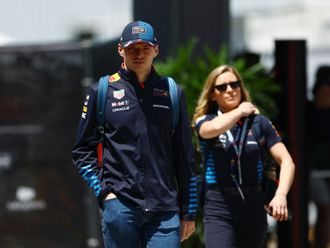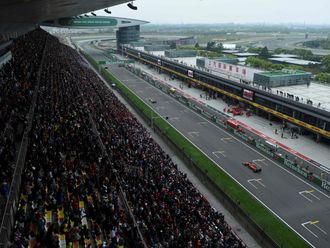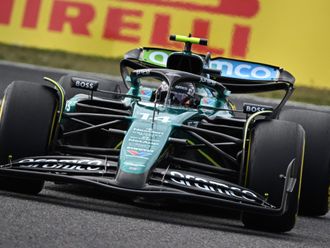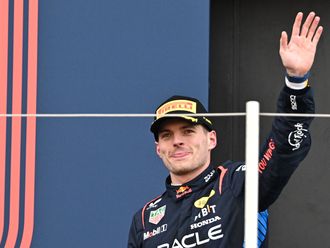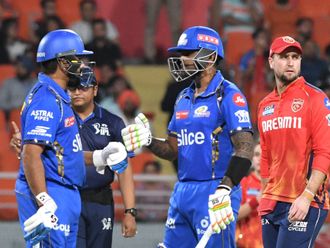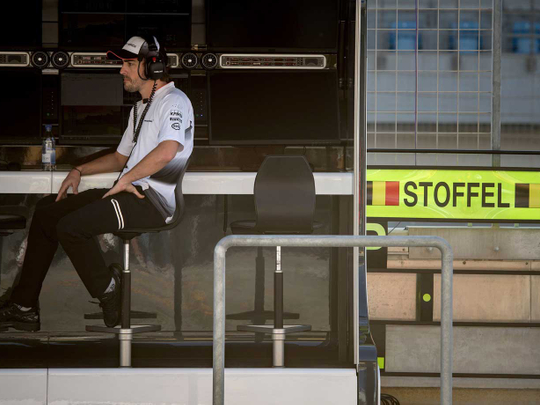
Dubai: Regarded by people in the know as the ‘most complete package’ in Formula 1, how is it that Fernando Alonso has ‘only’ won two world championships, with the last being a decade ago? Surely someone of his stature and magnitude should be pointing to at least four titles.
Watching this ‘complete package’ struggle at the back and then sit perched on the pit wall during the Bahrain Grand Prix on Sunday has been ever-so sad.
Where did it all go wrong?
It was back in 2001 when a very young Alonso first appeared on the Formula 1 grid. Then the third-youngest driver in the sport’s history, he was plucked from the junior ranks by the tail-ending Minardi team, where on his debut he out-qualified his teammate by 2.5 seconds.
A series of notable performances in that year drew the attention of bigger teams, with the charismatic – and unscrupulous – Flavio Briatore opting to take him on as Renault’s test driver for 2002.
And so the young Alonso would spend the year on the side-lines, but notched up over 2,000km in testing. Briatore dropped Jenson Button for 2003, replacing him with the young Spaniard to partner the experienced Jarno Trulli.
His ability and potential as a future champion became quickly obvious. In Malaysia he became the sport’s youngest-ever pole-sitter before he finished second in his home race just two weeks after an horrendous 240kp/h crash in Brazil.
The defining moment came in Hungary that year. Alonso had qualified on pole ahead of title contenders Ralf Schumacher, Juan-Pablo Montoya and Kimi Raikkonen, with the eventual and current world champion, Michael Schumacher, down in eighth. The 22-year old Spaniard made a clean start and never looked back as he went on to win in astonishing fashion to become the sport’s youngest race-winner.
He beat McLaren’s Raikkonen by 17 seconds, and in an act of things to come, even lapped the great Schumacher.
The following year he failed to win, but made it onto the podium four times, before greatness finally beckoned in 2005.
Joined by Giancarlo Fisichella at Renault, it was looking like the experienced Italian would be leading the team after a win in Australia, but Alonso had other ideas. He won the following three races and until Canada had finished in the top four at every race.
The season was all about Alonso and Raikkonen, but it would be the Spaniard who would take the first of what was expected to be many world championships.
It was no fluke, as in 2006 a resurgent, but retiring, Michael Schumacher wanted to go out with one last title. He and Alonso traded blows and wins all year, and the title fight went down to the final race. Alonso won again, and in doing so had beaten arguably the greatest Formula 1 driver of all time.
Schumacher was old news; Alonso was the new king of the castle. And standing on the edge of greatness, it all started to fall apart.
Alonso moved to McLaren for 2007 to partner young debutant Lewis Hamilton, who had been nurtured since age nine by the Woking team. Alonso entered the team on the – tellingly incorrect – assumption that he would be the de facto team leader. He expected to have what Schumacher had had for all those years: that he would be Number 1, and his teammate would be there to help him re-write history.
It wasn’t to be, and his season quickly imploded.
Hamilton proved a threat, not just as a cavalier rookie, but a genuine title challenger. Alonso became more and more frustrated that he was being matched, and even beaten, by Hamilton. But he was even angrier with how team boss Ron Dennis wasn’t doing anything to halt Hamilton’s charge.
It came to blows in Hungary when Alonso deliberately hogged the pit lane in qualifying, denying Hamilton the chance to set a faster time. McLaren was furious and the relationship went nuclear, with the Spaniard invited to leave at the end of the year.
In revenge for not being the favoured son, Alonso alerted the FIA that McLaren had ‘stolen’, and were using, Ferrari data. The outcome devastated the team: they were fined $100,000,000 and expunged from the constructor’s championship.
With all the top drives gone, Alonso went back to Renault for 2008, who by now was head of the midfield and not consistent front-runners. However he would go on to win back-to-back in Singapore and Japan, prompting him to remain with the team for 2009.
However, another massive controversy was on the way. His teammate, Nelson Piquet Jr, was sacked after 10 races after a run of poor displays. Bitter, Piquet Jr blew the whistle on what would become an even greater scandal than McLaren’s espionage case of 2007.
It transpired that Renault bosses Flavio Briatore and Pat Symonds had instructed Piquet Jr to crash deliberately in the 2008 Singapore Grand Prix, which gave Alonso a sporting advantage and subsequent win.
Alonso somehow managed to stay out of the drama, barely even acknowledging it. He left the ruined Renault team behind and took himself to Ferrari in 2010 where, he hoped, he could finally emulate Schumacher’s greatness.
Alonso’s move to Ferrari had been one of the worst-kept secrets in the sport for a while, and it was clear he was only using Renault as a waiting room. Ferrari had to pay Raikkonen a huge sum to leave the team so they could squeeze him in.
It was a fairy-tale start in 2010 as he won the opening round in Bahrain. The season was to be a classic as he, Red Bull’s Sebastian Vettel and Mark Webber and McLaren’s Lewis Hamilton and Jenson Button would keep a five-way title fight alive for the entire season.
Alonso was looking like the favourite as they entered the final race of the year in Abu Dhabi, but a strategy call left him fighting with Webber behind the stubborn Vitaly Petrov. Alonso couldn’t pass the Russian – who was ironically driving a Lotus, which had taken over from Renault – and the title went to Vettel.
And so began the “Red Bull Era”, where Sebastian Vettel would sweep to four consecutive world titles. Alonso nearly won in 2012, but missed out by a single point after an astonishing drive from the German in the last race of the season.
After five years in Maranello, Alonso scored 11 wins from 96 races. It seemed as if that elusive third title wasn’t going to be won in scarlet and so, astonishingly, he signed a deal to return to McLaren for 2015.
Last season was an appalling year for both McLaren-Honda and Alonso, and 2016 hasn’t shown signs of being notably better. Last year the car was several seconds off the pace and plagued by hysterically woeful reliability. The team didn’t score a single point.
After two races in 2016, Alonso has suffered a massive accident, and as a result had to miss the second.
Should he have moved around so much?
If he’d not left McLaren in 2007 he’d of had a title winning car in 2008. If he’d not left Ferrari at the end of 2014 he could very well be a title-winning car this year.
But there’s no ifs and buts needed, really. He has the on-track deviance and aggression of Michael Schumacher, the raw skill of Ayrton Senna, the political head of Alain Prost, and the foolhardiness of a driver who will do anything to win – literally anything.
As he stood there on the pit wall in Bahrain, he would have been looking at Sebastian Vettel and Lewis Hamilton, who between them have won seven world championships in the 10 years since Alonso won his last. He may see them as lucky as being in the right place at the right time. Yet he was too, but sometimes it’s just not meant to be.
Alonso is a ruthless winner, humbled.


